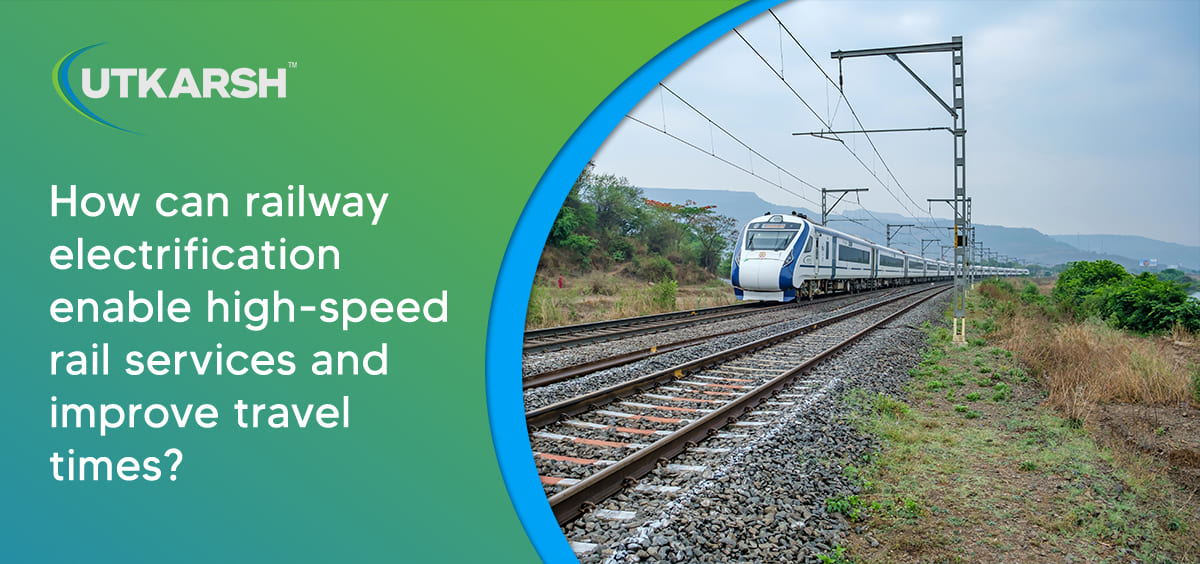How can railway electrification enable high-speed rail services and improve travel times?

The history of railway electrification in India dates back to the 1920s when the first electric train operated between Bombay VT and Kurla Harbour in February 1925. Following India's independence, the government recognised the need to reduce reliance on imported oil and improve air quality, leading to a focused initiative to electrify the railways. In the 1950s, Project Office for Railway Electrification (PORE) - now renamed as the Central Organization for Railway Electrification (CORE) - was established to oversee and manage the electrification program. In recent years, there has been significant progress in railway electrification. The government has set an ambitious target of electrifying the entire broad-gauge network by 2023. The Central Railway has accomplished a significant milestone by achieving 100% electrification on all its Broad Gauge routes. This accelerated pace reflects the commitment towards sustainable transportation and reducing the environmental impact of the railways in India. Railway electrification not only offers environmental benefits but also enables faster travel times, high-speed rail services, improved reliability, and enhanced passenger experiences. It paves the way for a more efficient, sustainable, and advanced rail transportation system. Here we share some of the useful insights into how railway electrification enables high-speed rail services and improve travel times:
- Faster and more efficient trains - Railway electrification helps trains with increased acceleration and higher maximum speeds, leading to expedited travel times. Electric trains outperform their diesel counterparts in terms of acceleration, enabling them to swiftly reach top speeds. This improved acceleration capability facilitates the maintenance of higher average speeds, ultimately reducing the duration of journeys between destinations.
- Enhanced infrastructure - Electrification of railway lines requires infrastructure upgrades, such as the installation of overhead electric wires and substations. These improvements enable a more efficient distribution of electricity, providing a reliable power supply to trains. As a result, high-speed trains can operate seamlessly without interruptions caused by refueling or engine maintenance. This leads to improved travel time predictability, as trains are less likely to be delayed due to technical issues.
- Reduced travel durations - High-speed electric trains can operate at speeds exceeding 300 kilometres per hour (km/h), substantially reducing journey durations between cities in India. For example, a high-speed train travelling at 300 km/h could travel the distance between Delhi and Mumbai in just 3 hours and 30 minutes. This is significantly faster than the current journey time of 15 hours by train. The Indian government is currently planning to build a number of high-speed rail corridors, including the Mumbai-Ahmedabad corridor and the Delhi-Varanasi corridor. These corridors are expected to be completed in the coming years, and they will help to transform India's transportation system.
- Increased frequency of trains - Electrified trains have a number of advantages over diesel trains, including faster acceleration and deceleration. This is because electric trains do not have to carry a heavy diesel engine, which allows them to be lighter and more manoeuvrable. The faster acceleration and deceleration of electric trains allows for increased train frequency. This means that there can be more trains running on a given route, which can lead to shorter waiting times for passengers. Increased train frequency also helps to alleviate congestion on roads and reduces the need for additional modes of transportation.
Looking for high-quality railway electrification structures?
Explore railway
electrification structures from Utkarsh India. We are an approved
vendor under the Central Organisation for Railway Electrification (CORE) PART I
standards. This approval is partly due to the purity of the raw materials used in
production. We use specialised high grade zinc with a purity of 99.995%. All of
the materials are sourced from reputed providers, such as SAIL and Hindustan
Zinc.
We operate two plants with 12.5 metre long hot dip galvanising
facilities. To provide convenience to our customers during the erection
process, we offer tower-wise bundling, making it easier for them at the site.
Our team consists of approved welders who possess the necessary skills and expertise to deliver exceptional craftsmanship. They work with the latest equipment, enabling precise and efficient manufacturing processes. Our Design Department is equipped with cutting-edge hardware and operates on an efficient ERP system. This ensures seamless coordination and enhances our ability to meet customer requirements accurately and promptly. With our commitment to quality, expertise, and the utilisation of advanced technology, we strive to provide our customers with products that meet the highest industry standards.